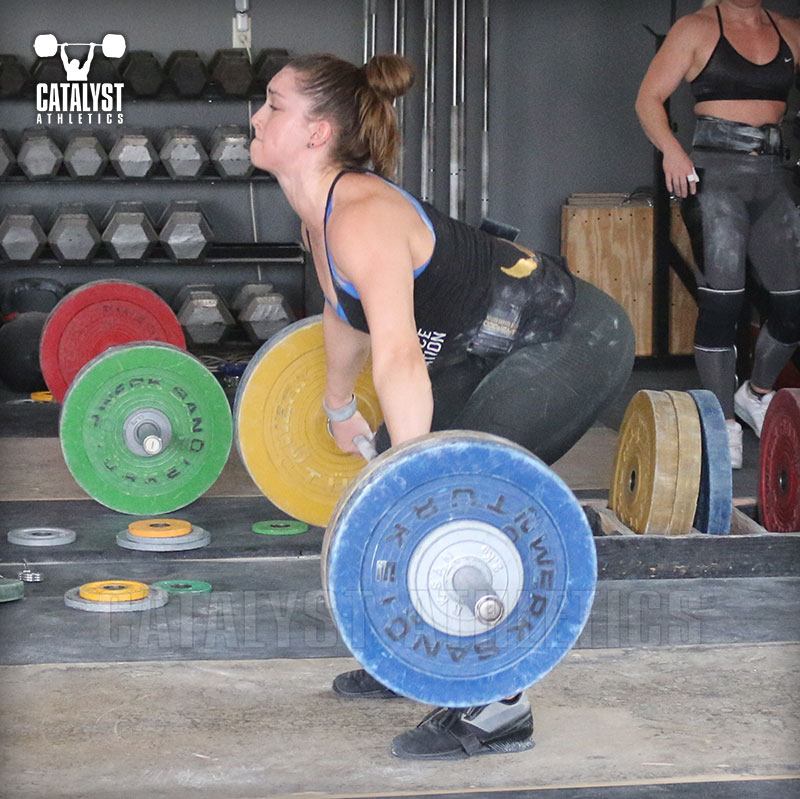Ask Greg: Issue 194

Paula Asks: Why do my knees come in when the bar is above the knees before I extend in snatch?
Greg Says: It’s usually a combination of weak hips and slack in the system. Include accessory and prep work that strengthens transverse abduction (moving the knees out with a flexed hip) and external rotation (rotating the upper leg outwardly)—to keep it simple, exercises that put the body in a position similar to that position in the middle of the pull and moving the knees outward. Throwing a mini band around the knees during any hip extension exercises like glute bridges, RDLs/SLDLs, good mornings, and all of your pull and deadlift variations, and actively pushing the knees out against its resistance, is a simple way to help without adding any time to your workouts.
Next, pay attention to your lifts as you transition from first to second pull—often athletes relax and slow down a bit as if they’re winding up for a harder acceleration, but this creates slack, which can allow the knees to move inward. We need continuous tension—never let up on the effort to drive against the floor and maintain position. When you accelerate into the second pull, just push harder—don’t lift your foot off the gas pedal to then stomp on it.
You can work on this most easily during pulls rather than snatches because there will be a lot less going on to worry about. Slow the first pull down significantly so you can feel that leg and hip tension and focus on maintaining it as you accelerate at the top of the pull. Again, throw a mini band around your knees also to feel that lateral hip engagement. Remember that we’re not trying to push the knees way out, but to maintain that tension to keep them in place.
Greg Says: It’s usually a combination of weak hips and slack in the system. Include accessory and prep work that strengthens transverse abduction (moving the knees out with a flexed hip) and external rotation (rotating the upper leg outwardly)—to keep it simple, exercises that put the body in a position similar to that position in the middle of the pull and moving the knees outward. Throwing a mini band around the knees during any hip extension exercises like glute bridges, RDLs/SLDLs, good mornings, and all of your pull and deadlift variations, and actively pushing the knees out against its resistance, is a simple way to help without adding any time to your workouts.
Next, pay attention to your lifts as you transition from first to second pull—often athletes relax and slow down a bit as if they’re winding up for a harder acceleration, but this creates slack, which can allow the knees to move inward. We need continuous tension—never let up on the effort to drive against the floor and maintain position. When you accelerate into the second pull, just push harder—don’t lift your foot off the gas pedal to then stomp on it.
You can work on this most easily during pulls rather than snatches because there will be a lot less going on to worry about. Slow the first pull down significantly so you can feel that leg and hip tension and focus on maintaining it as you accelerate at the top of the pull. Again, throw a mini band around your knees also to feel that lateral hip engagement. Remember that we’re not trying to push the knees way out, but to maintain that tension to keep them in place.
| Greg Everett is the owner of Catalyst Athletics, publisher of The Performance Menu Journal and author of Olympic Weightlifting: A Complete Guide for Athletes & Coaches, Olympic Weightlifting for Sports, and The Portable Greg Everett, and is the writer, director, producer, editor, etc of the independent documentary American Weightlifting. Follow him on Facebook here. |
Search Articles
Article Categories
Sort by Author
Sort by Issue & Date
Article Categories
Sort by Author
Sort by Issue & Date

